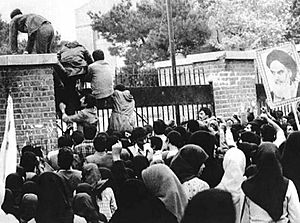Iran hostage crisis facts for kids
The Iran hostage crisis was a serious disagreement between Iran and the United States. Fifty-two American diplomats and citizens were held hostage for 444 days. This happened from November 4, 1979, to January 20, 1981. A group of Iranian students, who supported the Iranian Revolution, took over the U.S. Embassy in Tehran. This event is known as the longest hostage crisis ever recorded.
President Jimmy Carter called the hostages "victims of a terrible act." He stated that the United States would not give in to demands. This crisis is seen as a very important event in the history of how Iran and the United States got along. Many experts believe it was a big reason why Jimmy Carter lost the 1980 presidential election.
Quick facts for kids Iran–United States Hostage Crisis |
|||||||
|---|---|---|---|---|---|---|---|
| Part of Consolidation of the Iranian Revolution | |||||||
|
Iranian students crowd the U.S. Embassy in Tehran (November 4, 1979) |
|||||||
|
|||||||
| Belligerents | |||||||
|
|||||||
| Commanders and leaders | |||||||
|
|||||||
| Casualties and losses | |||||||
| 1 Iranian civilian and 8 American servicemen killed during an attempt to rescue the hostages. | |||||||
End of the Crisis
The hostages were finally released on January 20, 1981. This happened after many talks between Iran and the United States. On that day, as President Ronald Reagan finished his speech after becoming president, the 52 American hostages were set free. They were handed over to U.S. officials.
Initially, 66 people were taken hostage. Most were from the embassy, and a few from other offices. Thirteen hostages were released earlier, between November 19 and 20, 1979. One more person was released on July 11, 1980.
What Happened Next
Less than a year after the embassy takeover, Iraq invaded Iran. The journalist Stephen Kinzer believes that the big change in how America and Iran got along encouraged Iraq's leader, Saddam Hussein. America's anger with Iran led it to help Iraq when the war turned against them. The United States gave Iraq things like helicopters and satellite information. This information was used to choose bombing targets. This help made anti-American feelings in Iran even stronger.
Taking the hostages did not fully work out for Iran in some ways. Iran lost international support for its war against Iraq. The agreement that freed the hostages was seen as mostly good for the United States. This was because it did not meet any of Iran’s first demands. However, the crisis did make Iranians who supported the hostage-taking feel stronger. Anti-American feelings became even more intense in Iran.
Impact on the United States
When the hostages returned to the United States, they received many gifts. These included lifetime passes to any minor league or Major League Baseball game.
In the year 2000, the hostages and their families tried to sue Iran. They used a law called the Antiterrorism Act of 1996. They first won the case because Iran did not defend itself. But then the U.S. State Department tried to stop the lawsuit. They worried it would make international relations difficult. Because of this, a judge ruled that the hostages could not be given money. This was due to the agreement the United States made when the hostages were freed.
The old U.S. Embassy building in Tehran is now used by Iran’s government. Since 2001, it has been a museum about the revolution. Outside the building, there is a bronze model like the Statue of Liberty on one side. On the other side, there is a statue showing one of the hostages.
Images for kids
-
Americans showed thanks for Canada's help in rescuing American diplomats.
-
The hostages getting off Freedom One, an Air Force Boeing C-137 Stratoliner plane, when they returned home.
See also
 In Spanish: Crisis de los rehenes en Irán para niños
In Spanish: Crisis de los rehenes en Irán para niños

















